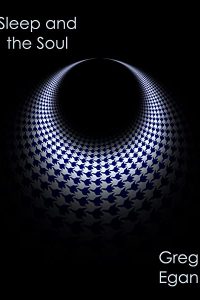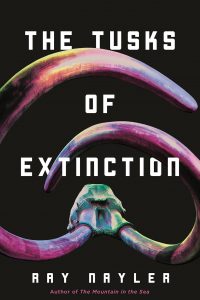Gary K. Wolfe Reviews The Very Best of Caitlín R. Kiernan
 The Very Best of Caitlín R. Kiernan, Caitlín R. Kiernan (Tachyon 978-1-61696-302-6, $17.95, 420pp, tp) February 2019.
The Very Best of Caitlín R. Kiernan, Caitlín R. Kiernan (Tachyon 978-1-61696-302-6, $17.95, 420pp, tp) February 2019.
The Very Best of Caitlín R. Kiernan, a title apparently meant to avoid confusion with the two volumes of The Best of Caitlín R. Kiernan published by Subterranean in 2011 and 2015, is probably as good a one-volume introduction to the variety of Kiernan’s work as we’re likely to get, though it draws almost entirely on the last 15 years of her career (with only one earlier story, from 2003). While there are certainly some worthwhile earlier stories, there’s an argument to be made that Kiernan, who has been consistently maturing as an author since the ’90s, really found her voice and her strongest themes in the early years of this century. The lyricism and striking imagery are still there, but what at times seemed an infatuation with style has given way to an approach that is somehow more disciplined and more experimental at the same time, as though a brilliant improvisational dancer had learned choreography. Kiernan has often made use of dreamlike imagery, but it takes a good deal of narrative confidence to get away with a story like “In View of Nothing”, the most purely dreamlike tale here, which preserves the odd narrative shifts of an actual dream while maintaining its emotional focus on the two women, one a failed assassin and the other an amputee who seems to represent some sort of authority, who are basically talking in a room for most of the story.
The same sort of narrative authority characterizes Kiernan’s approach to the older traditions of the horror fiction with which she was once associated. The Lovecraftian undertones of “One Tree Hill (The World as Cataclysm)” or “Andromeda Among the Stones” subsume Lovecraft’s language of revulsion into a kind of dark lyricism; the latter, rather pointedly set in California rather than the familiar eldritch stomping ground of New England, concerns the Dandridge family (whose patriarch is significantly named Machen), and the grotesque curse that follows them after the father returns from the Middle East with a “terrible black book.” Each family member is given voice as a character rather than merely as an outré setpiece, giving emotional resonance to a grim family saga. Much the same might be said of “Fish Bride (1970)”, with its echoes of Lovecraft’s Innsmouth and talk of “gods from the bottom of the ocean,” but with its central focus on two characters trying to learn how to be together. “Houses Under the Sea” also evokes Lovecraftian sea-terrors, but in the context of a much more contemporary-sounding California death cult. This doesn’t mean that Kiernan can’t foreground the horror when she wants to; probably the most traditionally plotted tale here, “Galápagos”, concerns a spaceship gone silent near Mars while returning from Ganymede, and what the protagonist finds when she boards it – an echo of the icky, all-absorbing alien growths from a dozen SF movies, which also manages to turn a Dylan Thomas poem into a horror story.
“Galápagos” is one of the collection’s few examples of Kiernan’s approach to SF, which, as with her approach to horror, has more to do with setting and tone than with genre conventions. The longest story, “Bradbury Weather”, is one of her best, but its meticulous Martian setting, and even its grotesque conclusion, is secondary to the troubled relationship between the narrator and the lover who fled her abuse, and whom she tracks across the planet. Another strained relationship between a narrator and her lover is at the center of the complex and remarkable “Tidal Forces”, which employs SF imagery in the form of a black hole which seems to be slowly devouring the lover. Kiernan likes to play with other genres as well, parodying Dashiell Hammett in “The Maltese Unicorn” (which rather subversively turns Hammett’s famous maguffin into an ancient, mystical dildo), adopting the lingo of a gangster tale in “Hydarargurus”, and even concocting a kind of steampunk Western in “The Steam Dancer (1896)”. Two stories from her sequence of Murder Ballads explore different modes as well; “The Ammonite Violin (Murder Ballad No. 4)”, one of the most elegantly structured tales, at times sounds like a Roald Dahl tale (the Dahl for grownups, not the peaches-and-chocolate Dahl), adopting the familiar trope of the crazed, obsessive collector, while “Interstate Love Song (Murder Ballad No. 8)” is a casually violent road trip featuring a pair of incestuous twin sisters wreaking bloody havoc (with an appropriate epigram from Cormac McCarthy).
Apart from the challenges of trying to sustain individual relationships, Kiernan’s most recurrent theme has to do with the not-quite-redemptive power of art. Three of the stories significantly feature movies: “The Ape’s Wife” offers some surprisingly touching variations on what might have happened to Ann Darrow from King Kong, while in “Fairy Tale of Wood Street” – another story of a strained relationship, complicated this time by the fact that one of them has a tail – the lovers talk largely in terms of movies, and try to resolve a crisis by going to see another movie, described in some detail. The most formally adventurous tale here, though, is the remarkable “The Prayer of Ninety Cats”, a second-person narration in which the reader is given the role of a film critic trying to make sense of a restored classic film about the real-life serial murderer Elizabeth Bathory. “La Peau Verte” is an evocative character portrait of an artist, her own career stalled, who takes jobs as an elaborately costumed model, making some important points about the nature of the artistic gaze, a topic which also comes up in “The Mermaid of the Concrete Ocean”, a haunting tale of an art journalist interviewing the aged model for a decades-old series of famous mermaid paintings, which originally appeared in Kiernan’s terrific novel The Drowning Girl, as a story written by the novel’s narrator. The fact that Kiernan can offer us a story allegedly written by one of her own creations, concerning another writer talking to a model about an artist, is a fine example of her sometimes palimpsest-like approach to her own storytelling, with tales that can shift dreamlike into other tales, tales lurking beneath the surface of other tales, tales woven like tapestries rather than conventionally linear plots. Kiernan’s writing does often demand close attention, but she’s earned it, and it pays off.
Gary K. Wolfe is Emeritus Professor of Humanities at Roosevelt University and a reviewer for Locus magazine since 1991. His reviews have been collected in Soundings (BSFA Award 2006; Hugo nominee), Bearings (Hugo nominee 2011), and Sightings (2011), and his Evaporating Genres: Essays on Fantastic Literature (Wesleyan) received the Locus Award in 2012. Earlier books include The Known and the Unknown: The Iconography of Science Fiction (Eaton Award, 1981), Harlan Ellison: The Edge of Forever (with Ellen Weil, 2002), and David Lindsay (1982). For the Library of America, he edited American Science Fiction: Nine Classic Novels of the 1950s in 2012, with a similar set for the 1960s forthcoming. He has received the Pilgrim Award from the Science Fiction Research Association, the Distinguished Scholarship Award from the International Association for the Fantastic in the Arts, and a Special World Fantasy Award for criticism. His 24-lecture series How Great Science Fiction Works appeared from The Great Courses in 2016. He has received six Hugo nominations, two for his reviews collections and four for The Coode Street Podcast, which he has co-hosted with Jonathan Strahan for more than 300 episodes. He lives in Chicago.
This review and more like it in the February 2019 issue of Locus.
 While you are here, please take a moment to support Locus with a one-time or recurring donation. We rely on reader donations to keep the magazine and site going, and would like to keep the site paywall free, but WE NEED YOUR FINANCIAL SUPPORT to continue quality coverage of the science fiction and fantasy field.
While you are here, please take a moment to support Locus with a one-time or recurring donation. We rely on reader donations to keep the magazine and site going, and would like to keep the site paywall free, but WE NEED YOUR FINANCIAL SUPPORT to continue quality coverage of the science fiction and fantasy field.







